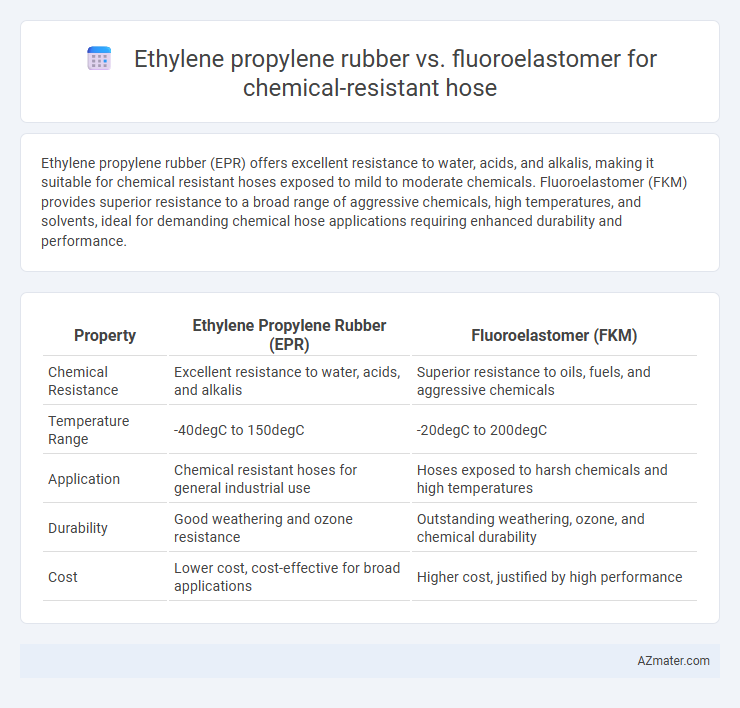Ethylene propylene rubber (EPR) offers excellent resistance to water, acids, and alkalis, making it suitable for chemical resistant hoses exposed to mild to moderate chemicals. Fluoroelastomer (FKM) provides superior resistance to a broad range of aggressive chemicals, high temperatures, and solvents, ideal for demanding chemical hose applications requiring enhanced durability and performance.
Table of Comparison
| Property | Ethylene Propylene Rubber (EPR) | Fluoroelastomer (FKM) |
|---|---|---|
| Chemical Resistance | Excellent resistance to water, acids, and alkalis | Superior resistance to oils, fuels, and aggressive chemicals |
| Temperature Range | -40degC to 150degC | -20degC to 200degC |
| Application | Chemical resistant hoses for general industrial use | Hoses exposed to harsh chemicals and high temperatures |
| Durability | Good weathering and ozone resistance | Outstanding weathering, ozone, and chemical durability |
| Cost | Lower cost, cost-effective for broad applications | Higher cost, justified by high performance |
Introduction to Chemical Resistant Hose Materials
Ethylene propylene rubber (EPR) offers excellent resistance to acids, alkalis, and water-based chemicals, making it a cost-effective choice for chemical resistant hose applications. Fluoroelastomer (FKM), known for its superior resistance to hydrocarbons, oils, fuels, and aggressive chemicals, provides enhanced durability in extreme temperature and chemical environments. Selecting between EPR and FKM depends on the specific chemical exposure, temperature range, and mechanical requirements of the hose application.
Overview of Ethylene Propylene Rubber (EPR)
Ethylene Propylene Rubber (EPR) is a versatile synthetic elastomer known for its excellent chemical resistance, particularly against acids, alkalis, and water-based chemicals, making it ideal for chemical-resistant hose applications. Its inherent resistance to heat, ozone, and weathering extends hose durability in harsh industrial environments. EPR's flexibility and temperature stability from -50degC to 130degC allow reliable performance in diverse chemical processing and fluid transfer tasks.
Overview of Fluoroelastomer (FKM)
Fluoroelastomer (FKM) is renowned for its excellent chemical resistance, particularly against fuels, oils, and aggressive solvents, making it ideal for use in chemical resistant hoses exposed to harsh environments. Compared to Ethylene Propylene Rubber (EPR), FKM offers superior performance in high-temperature conditions, maintaining flexibility and sealing integrity up to approximately 200-250degC. Its robust resistance to aromatic and chlorinated hydrocarbons ensures enhanced durability and longevity in demanding industrial applications where chemical exposure is prevalent.
Chemical Resistance Capabilities Comparison
Ethylene propylene rubber (EPR) exhibits strong resistance to a wide range of chemicals such as acids, alkalis, and ozone, making it suitable for various industrial hoses exposed to harsh environments. Fluoroelastomers (FKM) outperform EPR in chemical resistance, particularly against aggressive fuels, oils, solvents, and high-temperature chemicals, maintaining integrity in extreme conditions up to 200degC. While EPR offers cost-effective protection for general chemical applications, fluoroelastomers provide superior durability and resistance in specialized, high-performance chemical hose applications.
Temperature Performance of EPR vs FKM
Ethylene propylene rubber (EPR) offers reliable chemical resistance with an operational temperature range typically between -50degC and 150degC, making it suitable for moderate temperature applications in chemical-resistant hoses. Fluoroelastomer (FKM) significantly outperforms EPR in temperature resistance, maintaining stability and flexibility up to 200degC or higher, which is critical for hoses exposed to extreme heat and aggressive chemicals. The superior thermal endurance of FKM ensures prolonged service life and enhanced safety in high-temperature chemical transfer environments compared to EPR.
Mechanical Properties and Durability
Ethylene propylene rubber (EPR) offers excellent flexibility and abrasion resistance, making it suitable for hoses requiring good mechanical strength under moderate chemical exposure. Fluoroelastomers (FKM), however, provide superior chemical resistance, high temperature tolerance up to 200degC, and enhanced durability against aggressive fuels and solvents, which significantly extends hose service life in harsh environments. While EPR excels in resistance to weathering and ozone, FKM outperforms in mechanical stability and longevity when exposed to corrosive chemicals and extreme operational conditions.
Cost Analysis and Economic Considerations
Ethylene propylene rubber (EPR) offers a cost-effective solution for chemical resistant hoses, with lower material and manufacturing expenses compared to fluoroelastomers (FKM). Fluoroelastomers provide superior chemical resistance and thermal stability, justifying their higher price in applications with aggressive fluids and extreme conditions. When evaluating economic considerations, EPR suits budgets requiring moderate chemical resistance, whereas FKM delivers long-term value through enhanced durability and reduced replacement frequency despite higher initial costs.
Application Suitability in Different Industries
Ethylene propylene rubber (EPR) excels in applications requiring excellent resistance to ozone, weathering, and a wide range of polar chemicals, making it ideal for automotive, electrical, and water treatment industries. Fluoroelastomers (FKM) offer superior resistance to high temperatures, aggressive chemicals, fuels, and oils, which suits the aerospace, chemical processing, and oil and gas sectors. Selecting between EPR and FKM hoses depends on the specific chemical exposure and temperature conditions prevalent in targeted industrial environments.
Installation and Maintenance Requirements
Ethylene propylene rubber (EPR) hoses offer easier installation due to their flexibility and lighter weight, reducing labor time and effort during setup. Fluoroelastomer hoses require more careful handling and specialized tools for installation because of their stiffness and chemical-resistant properties. Maintenance for EPR hoses is generally less demanding, with periodic inspection for swelling or degradation, while fluoroelastomer hoses demand rigorous monitoring to prevent damage from chemical exposure and high temperatures, ensuring longevity and safety.
Conclusion: Selecting the Right Material for Chemical Resistant Hoses
Ethylene propylene rubber (EPR) and fluoroelastomer (FKM) both offer excellent chemical resistance, but fluoroelastomer outperforms EPR in handling aggressive chemicals, high temperatures, and solvents, making it ideal for demanding industrial applications. EPR is cost-effective and suitable for moderate chemical exposure and lower temperature ranges, commonly used in water, steam, and mild acid environments. Selecting the right material depends on factors like chemical compatibility, operating temperature, cost constraints, and durability requirements to ensure optimal hose performance and longevity.

Infographic: Ethylene propylene rubber vs Fluoroelastomer for Chemical resistant hose
 azmater.com
azmater.com